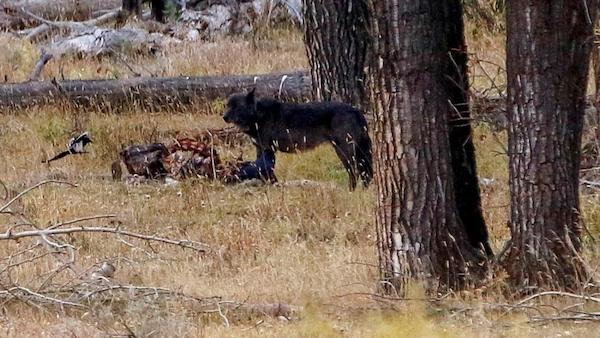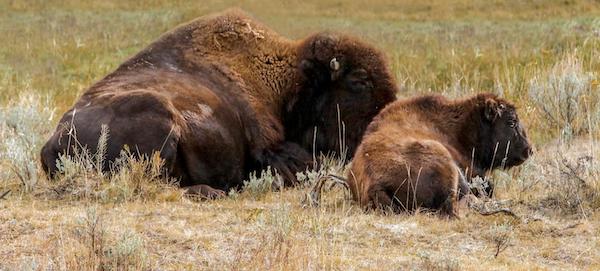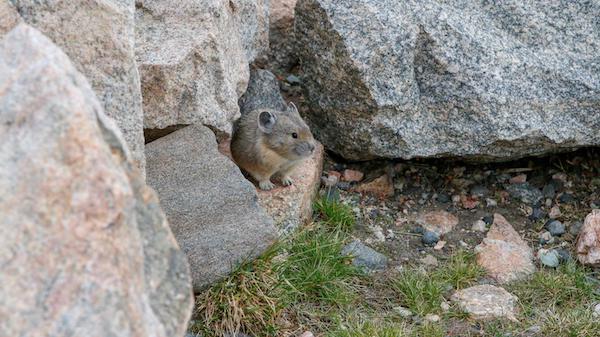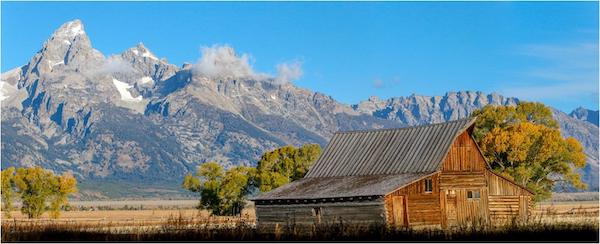Nat Hab travelers Lois O. Gray and Kay Gilmour recently journeyed on our Hidden Yellowstone Photo Safari and shared details of their encounters with wolves in the Lamar Valley and other wildlife along the way.
From Huge Wolves to Tiny Pika
Lamar Valley was our next destination as we drove towards Cooke City, Montana, for our two night stay in search of wolves, our primary target for photo-shooting. The drive was dramatic and picturesque especially when we could see bighorn sheep high up on the walls of the steep mountains above us. On the grasslands of the Lamar Valley were hundreds of bison peacefully grazing. Soon, we were rewarded with faraway tiny dark specks way off the road. The wolves were almost a mile in the distance. Our guides told us that we were looking at a wolf pack named Junction. With careful observation through spotting scopes and high powered binoculars, we began to make out the activities of the wolves in the growing light of dawn. We could see the pack getting reacquainted in a morning ritual, very much like dogs.
There was much tail wagging, friendly wrestling, butt sniffing, running and chasing going on. Our guide showed us how to take videos with smartphones through the spotting scope! That was really amazing and gave everyone a chance to get video footage to show friends and family.

iPhone Lens against Spotting Scope Eyepiece
As the wolves left the scene, we jumped into the vans and drove north ourselves hoping to find a spot where the wolves would come out from the trees and brush so we could see them again. When we stopped, we saw three wolves emerge from the foliage and run down a short hill only to disappear into a ravine filled with rabbitbrush.

We moved a little further on down the road, stopping when we saw ravens and magpies gathering in a clearing in the forest. The guides were sure that there was a carcass from an earlier kill in that area. We sat and watched and soon a black wolf appeared in the distance.
With no hesitation, he moved quickly to the carcass and began eating. We were now within 150 yards of him.

The birds added to the show as they stealthily approached the carcass while watching the wolf intently. He appeared to show them no attention whatsoever, so one or two would become bolder and move a little closer. Like kittens at play, all the birds reacted to any moves the wolf made. If he lifted his head, they jumped back. If he turned his body, they sprang backward. Then they would carefully sneak closer again. Finally, the bravest (or cheekiest) of the group actually reached the kill and quickly snatched a bite!
We were all exhilarated by this wolf encounter and most everyone was able to make satisfactory photographs—at least good enough to prove we had seen the wolves!

We drove off from the wolf scene and went down a gravel road to Slough Creek. We saw an enormous bison herd with members of all ages, both males and females. There were fairly young calves standing close to their mothers, some of them nursing. It was still cold enough for us to see the breath floating out of the animals’ nostrils. It was a beautiful scene with the bison standing in golden pastures with rugged mountains behind them and gray storm clouds hanging over them.

We then drove to the cabin of Dan and Cindy Hartman. Dan’s fantastic wildlife photos adorned the walls with old tools and needlework hanging among them. There were handmade quilts draped on beds and furniture, and old pieces of crockery on kitchen counters and tables.
Dan launched into his role as raconteur, wilderness explorer, conservationist and wildlife photographer extraordinaire. Though he admitted it was difficult for them at first to make a living in this small town, he and Cindy had persevered until he became well-recognized for his skills as a photographer. He also acts as a guide and expert for many documentarians, like David Attenborough, and magazines such as National Geographic and World Wildlife.
He showed us some truly magnificent photos he has been preparing for a documentary on Great Gray Owls. He has to trek into the forests to find the nests and then brings his photography equipment and practices enormous patience in waiting for owl action shots.

We were assured we would be in Dan’s company again later in the afternoon when he accompanied us up on the Bear Tooth Highway in search of wildlife, particularly the most adorable creature of the mountains—the pika. It was still a very overcast day with heavy thunderclouds overhead when we picked Dan up for the drive up to 11,000 ft on the highway which Charles Kuralt made famous by calling it the most beautiful drive in the USA.

 He certainly didn’t exaggerate either. Even under those heavy clouds, strong wind gusts, and chilly temperatures, the drive was magnificent. Of course, we had many stops at particularly advantageous overlooks, but it would be hard to say which one was the most impressive. Red-tailed hawks and a bald eagle appeared overhead. Perhaps they were greeting their old friend, Dan.
He certainly didn’t exaggerate either. Even under those heavy clouds, strong wind gusts, and chilly temperatures, the drive was magnificent. Of course, we had many stops at particularly advantageous overlooks, but it would be hard to say which one was the most impressive. Red-tailed hawks and a bald eagle appeared overhead. Perhaps they were greeting their old friend, Dan.
After some diligent and patient searching, Dan finally located the particular pile of boulders where he could show us the pika he knew were in the area. This tiny member of the rabbit family is probably the cutest creature Mother Nature ever created: small (just a few ounces), round body, short rounded ears, no visible tail and sweet little feet. No one could resist a pika once he actually saw one. Pikas hurt no other creature and live on vegetation (mainly grasses) which they collect all summer for winter food. Their food caches are known as hay piles. They live at high altitudes in North America, usually above 10,000 feet. They do not hibernate; they estivate which means they stay in their nests and/or burrows during winter, lower their metabolic rate and sleep often but eat throughout the winter. Extreme heat, just like cold, can cause pikas to estivate.
It took a considerable amount of time and patience to finally spot some of the charming little creatures scurrying around among the rocks and boulders, no doubt finishing up their “haying” activities before winter sets in hard. The photographers were happy with their “live captures” of these wonderful little creatures.

When we returned to Cooke City for supper, we all exulted over our wonderful day with wolves and pikas and Dan Hartman! What more could any of us have asked for?

Yellowstone Falls
The next day, we had a scenic stop at Upper Yellowstone Falls, a tumultuous cascade dropping 109 feet into a deep canyon with sporadic trees coming from the walls. The scene is so grand it often appears to be a painting rather than something real. We shared the viewpoint with several other travelers who seemed equally enthralled with the beauty in front of them, trying for selfies with the falls behind them or setting up tripods to get steadier shots.
Mud Volcano
Mud Volcano was our next goal. This volcano was discovered and described back in 1871 when it was said to be extremely active, flinging mud high in the sky and producing loud explosive sounds. It quieted very quickly afterward and remained calm until some small earthquake tremors in 1979 when it reactivated and began bellowing and slinging mud all over the boardwalks from deep inside the 17 foot crater. Today it has settled back down and just bubbles and churns, making little burping sounds as the mud and water stir about in the crater. There is also the hydrogen sulfide smell of “rotten eggs” all over the area: just another dramatic reminder of the fact that the Greater Yellowstone Ecosystem is inside a huge volcanic crater that has never been silent since its huge eruption thousands of years in the past. Who can say when it will decide to completely blow up again?

Our last day of the trip started off early with another spectacular sunrise.

We then drove across Antelope Flats towards the iconic old barn shot. The barn is located by itself in a field of hay with the Tetons looming in the background. Kay’s pictures resonated with us.

Later, we were rewarded with two moose who were tucked into the tall grasses under some trees across the river. The bull’s rack was very impressive and I am sure the photo bugs were happy to capture that necessary shot.

We saw more pronghorn and several female mule deer along the way as well. On this trip, there was never a moment without some sort of wildlife observation!


























